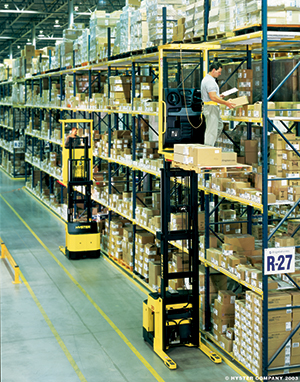 Steve Reynolds |
Steve Reynolds is the Victorian Sales Manager and has worked at Adaptalift Hyster since April 2010, having previously worked for Hyster since 2006 prior to the acquisition. As well as managing a successful sales team in Victoria, Steve deals with big truck customers, assisting them in making the right choice for their particular applications.
1. Operating at more than 1 metre from the groundIf operating at more than 1 metre from the ground, the machine must be lowered to 600mm or lower before moving forward or reversing to the next location. This is important as the stability of the load at height may be affected when moving.
The machine must then come to a stop before being raised to the desired working height again. All order pickers are fitted with limit switches to prevent them from driving at height. These switches must never be tampered with.
2. Safe travel height The machine must come to a stop before being raised |
The order picker must be lowered to a safe travel height before turning a corner or exiting an aisle. A safe travel height is clear of the ground but below axle height. This will ensure the order picker does not tip over.
3. Wearing a harnessWhen operating an order picker, a harness must be worn at all times and, when moving, the handrail must be closed on the platform. This will prevent falls from the order picker.
4. Traffic managementTraffic management is another important aspect of safety when operating an order picker. Making people aware of areas of operation is the easiest way to avoid risks and this can be done by:
* Posting signs
* Erecting barriers
* Using a flag person to control the flow of traffic
5. Potential hazardsIt is extremely important to ensure all work areas are free of potential hazards. The safest path to take when moving a load and operating the order picker should always be considered in order to prevent any accidents, injury to other personnel or damage to machinery, equipment and stock.
What to watch out for in the work area:
* What hazards are present?
* Where will you be required to stop?
* Where should you slow down?
* Where should you sound your horn?
* Will you need to reverse?
* Is ventilation adequate?
* Is there adequate lighting?
* Do you have room to move?
* What is a safe speed?
* Is the ground surface suitable?
* What clearance do you have?
Are these precautions carried out in your warehouse?